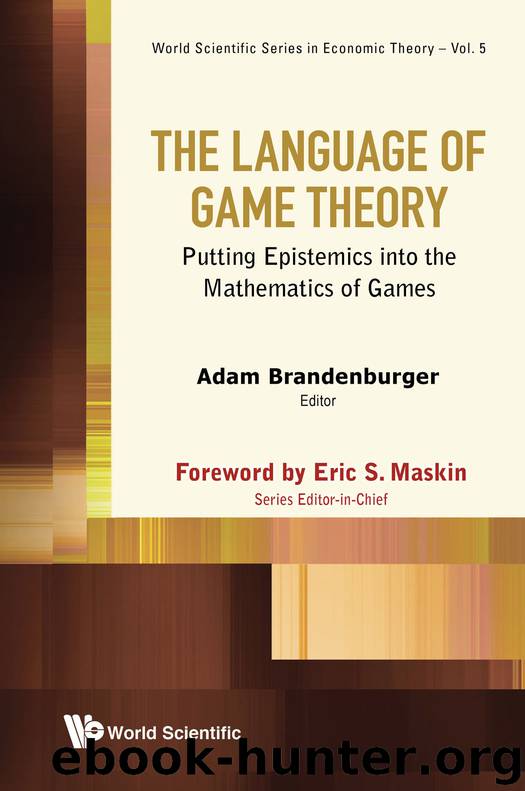The Language of Game Theory by Brandenburger Adam

Author:Brandenburger, Adam.
Language: eng
Format: epub
ISBN: 9789814513456
Publisher: World Scientific Publishing Company
Published: 2014-03-15T04:00:00+00:00
Figure 5.
Figure 6.
As for Matt, suppose first that he is of type W1 or W2. Each of these types intersects two adjacent boxes in Figure 6; it consists of the diagonal states in the left box and the off-diagonal ones in the right box. The diagonal states on the left have equal probability, as do the off-diagonal ones on the right; but on the left it is three times on the right. So Matt assigns the diagonal states three times the probability of the off-diagonal states; i.e., his conjecture is . Therefore, his expected payoff from choosing W is , whereas from E it is only 2 (as all his payoffs in the eastern matrix are 2). So W is indeed the optimal action of these types; so they are rational. It may be checked that also E1 and W3 are rational. Thus, the rationality of all players is commonly known at all states.
Consider now the state s := (H2, h2, W2) (the top left state in the middle box). Rowena and Colin know at s that they are in the middle box, so they know that Matt’s type is W1 or W2. We have just seen that these two types have the same conjecture, so it follows that Matt’s conjecture is mutually known at s. Also Rowena’s and Colin’s conjectures are mutually known at s (Rowena’s is , Colin’s is ).
Finally, the individual conjectures derived from Matt’s overall conjecture are for Rowena and for Colin. These are the same as Rowena’s and Colin’s conjectures about each other. Since Matt plays W throughout the middle box, both Rowena and Colin conjecture W for Colin there. Thus, throughout the middle box, individual conjectures are agreed upon.
To sum up: There is a common prior; at all states, the game is commonly known and all players are commonly known to be rational. At the top left state in the middle box, the overall conjectures of all players are mutually known, and the individual conjectures are agreed: , , σM = W. But (σR, σC, σM) is not a Nash equilibrium.
One can construct similar examples in which the mutual knowledge of the conjectures is of arbitrarily high order, simply by using more boxes; the result follows as before.
Example 5.3. Here we show that one cannot dispense with common priors in Theorem B. Consider again the game of Figure 5, with the theories depicted in Figure 7 (presented in the style of Figure 2). At each state there is common knowledge of rationality, of the overall conjectures (which are the same as in the previous example), and of the game. As before, individual conjectures are in agreement. And as before, the individual conjectures (, , W) do not constitute a Nash equilibrium.
Download
This site does not store any files on its server. We only index and link to content provided by other sites. Please contact the content providers to delete copyright contents if any and email us, we'll remove relevant links or contents immediately.
Modelling of Convective Heat and Mass Transfer in Rotating Flows by Igor V. Shevchuk(6348)
Weapons of Math Destruction by Cathy O'Neil(6074)
Factfulness: Ten Reasons We're Wrong About the World – and Why Things Are Better Than You Think by Hans Rosling(4617)
Descartes' Error by Antonio Damasio(3183)
A Mind For Numbers: How to Excel at Math and Science (Even If You Flunked Algebra) by Barbara Oakley(3176)
Factfulness_Ten Reasons We're Wrong About the World_and Why Things Are Better Than You Think by Hans Rosling(3157)
TCP IP by Todd Lammle(3093)
Applied Predictive Modeling by Max Kuhn & Kjell Johnson(2973)
Fooled by Randomness: The Hidden Role of Chance in Life and in the Markets by Nassim Nicholas Taleb(2962)
The Tyranny of Metrics by Jerry Z. Muller(2950)
The Book of Numbers by Peter Bentley(2870)
The Great Unknown by Marcus du Sautoy(2608)
Once Upon an Algorithm by Martin Erwig(2536)
Easy Algebra Step-by-Step by Sandra Luna McCune(2533)
Lady Luck by Kristen Ashley(2493)
Practical Guide To Principal Component Methods in R (Multivariate Analysis Book 2) by Alboukadel Kassambara(2444)
Police Exams Prep 2018-2019 by Kaplan Test Prep(2438)
All Things Reconsidered by Bill Thompson III(2323)
Linear Time-Invariant Systems, Behaviors and Modules by Ulrich Oberst & Martin Scheicher & Ingrid Scheicher(2301)
